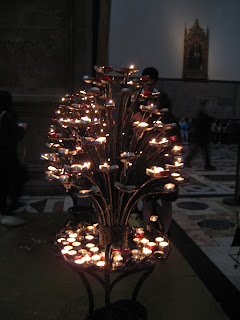SO! Roma! The eternal city! and most of looks like it's been here forever... older than even us!
Our train ran a bit late (do NOT travel with us: we have a curse! ours was the only delayed train on the board) but the ride was otherwise uneventful; downright pleasant, in fact.
From Roma Terminii we took the subway to Lepanto and walked about a half mile to the hotel. That's right, Carol rode the subway! It cost 1 Euro each. (which was good for 75 minutes)
The subway was the safe part of the trip: the drivers don't try to hit you, but they do seem to be trying to run over your toes. (that way their car isn't damaged AND you can't chase them!)
We walked for a few hours looking (in vain) for a particular Irish Pub (burger & beer deal advertised) but wound up eating a piece of pizza instead. The streets and piazzas just got busier as it got later. At 10pm, rain be damned, people were everywhere and going in all directions: the restaurants were hopping and the roads clogged.
English-speakers are harder to find than in Florence and Venice, so asking for help was fruitless. (luckily, we worked on the language and are otherwise getting by)
The streets are narrow and cobbled, largely dark, but seem safe at night. Navigating is a pain because there are no straight roads, streets are very short and street names change at almost every "corner", or piazza. Street names are carved into stone on buildings, usually 12 - 15 ft high, and almost every 'intersection' is some kind of piazza. (I think maybe they have too many dead people to remember and not enough roads!)

At the close of a morning tour we visited Vatican City and got a treat. Il Papa addresses the throngs gathered for some sort of agricultural celebration, at the end of which the Papal blessing was bestowed upon us and our belongings!

The Pope is standing in a window of his residence (next to St. Peter's) giving his presentation. The Vatican broadcasting service had many vehicles with large TV screens and loudspeakers and the whole thing was presented better than most events we are used to!

Next it was the ancient city. There's too much to say. The Colosseum alone is a lot to take in but only a fraction of what's there. Once it was complete, but an immense amount of material was pillaged to build other things (truly the underlying theme in most of what we've experienced here) and yet what remains is so thrilling.

Finally, we entered the Foro Romano, an immense dig site adjacent to the colosseum, where remains of the original Roman Forum continue to be unearthed. Note the Roman road paving.
Where they've dug deeper they've found earlier remians: recycling takes on a whole, old meaning.
It will take days for us to simply SEE everything in the ancient city, which is immensly more interesting than most of modern Rome.






































